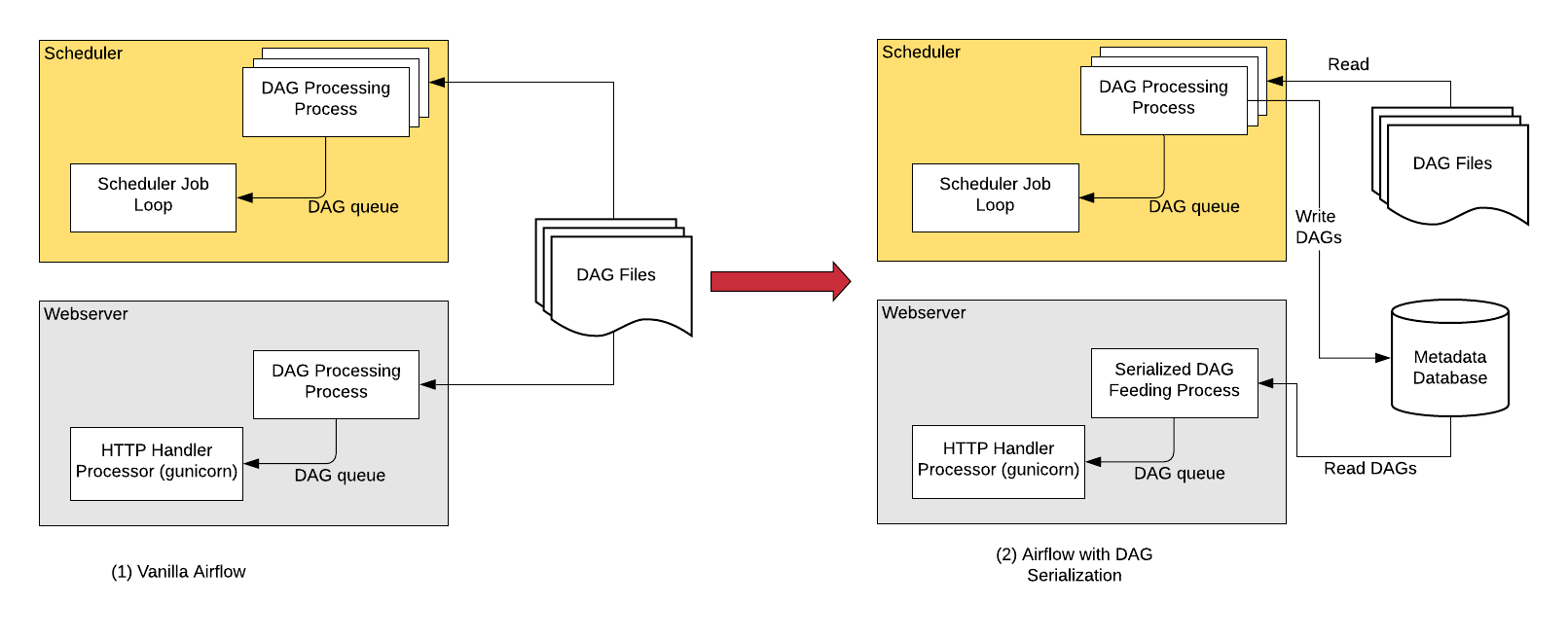DAG Serialization¶
In order to make Airflow Webserver stateless, Airflow >=1.10.7 supports DAG Serialization and DB Persistence.

Without DAG Serialization & persistence in DB, the Webserver and the Scheduler both need access to the DAG files. Both the scheduler and webserver parse the DAG files.
With DAG Serialization we aim to decouple the webserver from DAG parsing which would make the Webserver very light-weight.
As shown in the image above, when using the this feature, the Scheduler parses the DAG files, serializes them in JSON format and saves them in the Metadata DB.
The Webserver now instead of having to parse the DAG file again, reads the serialized DAGs in JSON, de-serializes them and create the DagBag and uses it to show in the UI.
One of the key features that is implemented as the part of DAG Serialization is that instead of loading an entire DagBag when the WebServer starts we only load each DAG on demand from the Serialized Dag table. This helps reduce Webserver startup time and memory. The reduction is notable when you have large number of DAGs.
Below is the screenshot of the serialized_dag table in Metadata DB:

Enable Dag Serialization¶
Add the following settings in airflow.cfg:
[core]
store_serialized_dags = True
min_serialized_dag_update_interval = 30
store_serialized_dags: This flag decides whether to serialise DAGs and persist them in DB. If set to True, Webserver reads from DB instead of parsing DAG filesmin_serialized_dag_update_interval: This flag sets the minimum interval (in seconds) after which the serialized DAG in DB should be updated. This helps in reducing database write rate.store_dag_code: This flag decides whether to persist DAG files code in DB. If set to True, Webserver reads file contents from DB instead of trying to access files in a DAG folder.
If you are updating Airflow from <1.10.7, please do not forget to run airflow upgradedb.
Limitations¶
When using user-defined filters and macros, the Rendered View in the Webserver might show incorrect results for TIs that have not yet executed as it might be using external modules that Webserver wont have access to. Use
airflow tasks rendercli command in such situation to debug or test rendering of you template_fields. Once the tasks execution starts the Rendered Template Fields will be stored in the DB in a separate table and after which the correct values would be showed in the Webserver (Rendered View tab).
Note
You need Airflow >= 1.10.10 for completely stateless Webserver. Airflow 1.10.7 to 1.10.9 needed access to Dag files in some cases. More Information: https://airflow.apache.org/docs/1.10.9/dag-serialization.html#limitations
Using a different JSON Library¶
To use a different JSON library instead of the standard json library like ujson, you need to
define a json variable in local Airflow settings (airflow_local_settings.py) file as follows:
import ujson
json = ujson